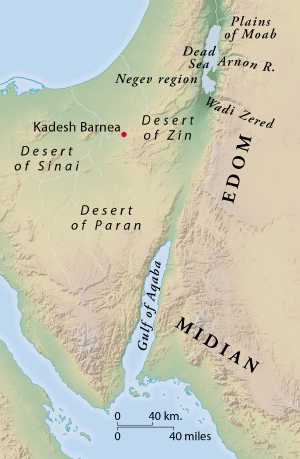Numbers
by R. Dennis Cole

Kadesh Barnea region
Z. Radovan/www.BibleLandPictures.com
Introduction
Title
The title “Numbers” derives from the Septuagint name Arithmoi, based especially on the census materials in chapters 1–4 and 26. The Hebrew title (bemidbar; “In the Wilderness”) describes the geographical setting of much of the book—from the Wilderness of Sinai to the arid Plains of Moab, across the Jordan River from Jericho.
Geographical Setting
Numbers contains three geographical settings, providing a thematic and theological program for the book. The first and the last are specific locales. The Wilderness of Sinai (1:1—10:10) is where the Israelites spent almost a year encamped at the base of Mount Sinai, the mountain of God. There Moses and the Israelites encountered God, received the gift of the law, and constructed the tabernacle and its holy furnishings. The final location was the Plains of Moab (22:1—36:13), where the second generation of Israelites prepared for the conquest of their promised inheritance.
Between these two locales is the journey through several rugged wilderness regions from the central Sinai peninsula to the Paran Wilderness (10:11—12:16), to the central Negev region of Kadesh Barnea and the Zin Wilderness (13:1—20:22), then into the arid southern Jordan regions of the Wadi Zered (20:22—21:9), then northward through the territories of the Moabites and Amorites, where God gave victory over Sihon and Og. These travels should have taken several months but lasted nearly forty years.
The question of where Moses and Israel encountered God has intrigued biblical scholars at least since the Byzantine period. Eusebius1 cites the preference for the traditional Mount Sinai at Jebel Musa in the rugged south central mountains, which towers up to 7,505 feet, while others proposed Jebel Serbal (6,791 feet) in the western ridge of the Sinai peninsula. The Christian preference for Jebel Musa led to the construction of the famous St. Catherine’s Monastery in the sixth century A.D., further strengthening that tradition.
No less than twenty different suggestions have been tendered through the centuries for other locations for Mount Sinai, such as Jebel Sin Bisher in the west-central Sinai peninsula (2,755 feet), Jebel Helal and Har Karkom in northeast Sinai, and even Jebel al-Lawz in northwest Saudia Arabia.2 The strongest support historically and geographically is for Jebel Musa, though the Jebel Sin Bisher location meets as many of the criteria (see esp. comments on 33:16). Locating Israelite campsites between Mount Sinai and Kadesh Barnea is dependent on the location of Mount Sinai (see charts in ch. 33).

Sinai Peninsula and the Book of Numbers
Historical Setting
Archaeologists and historians date the Israelite wilderness sojourn to the middle or latter part of the Late Bronze Age (1550–1200 B.C.) in the ancient Near East. The world of Egypt, the eastern Mediterranean, and Mesopotamia experienced dramatic political and territorial transitions during this era. Egypt conquered the lands of Canaan and beyond under Eighteenth Dynasty kings Thutmose I and Thutmose III, only to see it diminish during the reign of Akhenaton. During the fifteenth century B.C. Egypt exacted extensive political and economic control over the region.
Yet in the fourteenth century as the Amarna letters reflect, the Egyptians experienced a significant loss of power among loyal Canaanite puppet-kings because of invasions from the Hapiru, Shasu, and other marauding bands. Then the Nineteenth Dynasty kings Seti I and Ramesses II restored the Egyptian hegemony over much of Canaan, having established a boundary with the Hittites at Qadesh on the Orontes River. Early Hebrew chronologists place the Exodus about 1442 B.C., under either Thutmose III or Amenhotep II, placing the forty-year wilderness sojourn during the reigns of Amenhotep II and Thutmose IV. Late Hebrew chronologists place both the Exodus and the wilderness period under Ramesses II.3
Whichever chronological scheme is taken, the terminus ad quem for Israel’s existence in Canaan is the mention of “Israel” in the Merneptah Stele (ca. 1209 B.C.). By that time Israel had established itself as a significant enough entity in the central hill country to be mentioned as one of the peoples defeated in the land of Canaan by the pharaoh Merneptah.4 By the end of the Late Bronze Age, because of massive migrations of peoples such as the Sea Peoples (including the Philistines, Sherdan, and Danoi) and international warfare, empires such as the Egyptians and Hittites and city-states such as Ugarit experienced dramatic collapse and even destruction.
Most important is that under either chronological scheme, God delivered the Israelites from Egypt during the reign of a powerful pharaoh who oversaw a vast empire that stretched through much of Canaan. The wilderness sojourn as described in Numbers came when the Egyptians focused on maintaining the lucrative trade routes through northern Sinai and into Canaan. The southern two-thirds of the Sinai region was less in focus during this era. Thus the Israelites’ experiences with God were less likely to be impacted by the imperial pursuits of her former taskmasters.
| Eighteenth and Nineteenth Dynasty Egyptian Pharaohs | |
|---|---|
| Eighteenth Dynasty | |
|
Pharaoh |
Regnal Dates |
|
Thutmose I |
1524–1518 B.C. |
|
Thutmose II |
1518–1504 B.C. |
|
Thutmose III |
1479–1425 B.C. ** (25 YEAR GAP) |
|
Hatshepsut |
1479–1457 B.C. |
|
Amenhotep II |
1453–1419 B.C. |
|
Thutmose IV |
1419–1386 B.C. |
|
Amenhotep III |
1402–1364 B.C. |
|
Akhenaton |
1352–1336 B.C. |
|
Smenkhare |
1336–1334 B.C. |
|
Tutankamun |
1337–1333 B.C. |
|
Ay |
1334–1325 B.C. |
|
Horemhab |
1323–1295 B.C. |
| Nineteenth Dynasty | |
|
Ramesses I |
1295–1294 B.C. |
|
Seti I |
1294–1279 B.C. |
|
Ramesses II |
1279–1213 B.C. |
|
Merneptah |
1213–1203 B.C. |